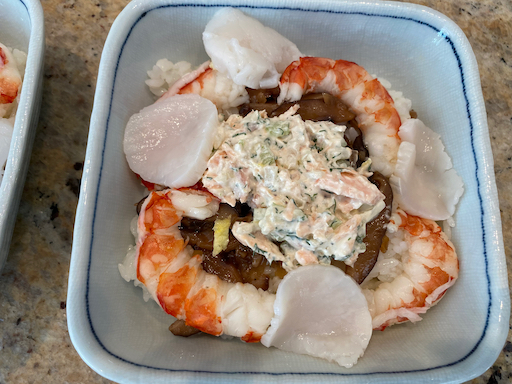January 2024
January 1,
Happy New Year 2024 明けましておめでとう2024
January 5,
Tomato and Egg Stir-fry with Wood Ear and Natto 納豆、トマト、木耳の卵炒め
January 22,
Goat Cheese Scallion Muffin ゴートチーズと青葱マフィン
January 25,
White "Pineberry" and Red "Koyo" Stawberries 白いイチゴと昂揚イチゴ
January 28,
Beef with Kon-nyaku and Vegetable "Kimpira" Stir Fry 牛肉と蒟蒻の金平
February 2024
February 3,
Chestnut Brown Butter, Sage Muffin 栗の粉とセイジマフィン
February 8,
Grated Lotus Root and Tofu Ball レンコン豆腐饅頭
February 11,
Sweet Onion Bread Pudding 玉ねぎのブレッドプディング
February 15,
Shad Roe from South Carolina 南カロライナからのシャドロウ
February 18,
Cranberry Camembert Cheese Bites クランベリーソース、カマンベールチーズ バイツ
February 21,
Simmered Shad Roe with Vegetables シャドロウの煮付け
February 24,
Shad Roe Pasta シャドロウパスタ
February 27,
Pickled Cucumber キュウリの漬物
March 2024
March 1,
“Maitake” Hen of the Woods Mushroom in Brown Butter and Sage 焦がしバターとセイジ風味舞茸
March 4,
Instant Pot BBQ Baby Back Ribs バーベキューベイビーバックリブ
March 7,
Salted Oatmeal Cookie 塩味オートミールクッキー
March 10,
Lobster Salad ロブスターサラダ
March13,
“Roman” Gnocchi ローマンニョキ
March 22,
Duck Tender Cutlet and Arancini 鴨ささ身のカツレツ
March 25,
Mary Walsh’s Currant Cake マリーウオルシュのカラントケーキ
March 28,
St. Patrick’s Day Dinner, Lamb Chops and Cabbage with bacon セントパトリックのディナー
April 2024
April 6,
Pumpkin “Kabocha” salad カボチャのサラダ
April 10,
Mini Fruit Galettes ミニフルーツガッレト
April 21,
Spinach Soufflé (easy version) ほうれん草のスフレ
April 30,
Frangipane Rolls フランジパンロール
May 2024
May 13,
Pickled Micro Cucumber and Daikon 小さなキュウリと大根のピクルス
May 15,
Steamed Carrot Buns with Ginger Custard 人参蒸しパン生姜カス...
May 18,
Braised Eggplant with Oyster Sauce 茄子と椎茸のオイスターソース炒め
May 21,
Creamed Spinach with Cauliflower Puree カリフラワーピュレのク
May 24,
Anchovy Salad アンチョビサラダ
May 27,
Daikon Steak and Two Appetizers 大根ステーキ
May 30,
Focaccia Bread Baked in Breville Pizzaiolo Indoor Pizza Oven
June 2024
June 2,
Steak and 2004 Joseph PhelpさんInsignia ステーキディナーと2004 インシグニア
June 5,
Gyoza made with New Round Gyoza Skin 日本風の餃子の皮で作った餃子
June 8,
Filled Wool Bread 毛糸のパン
June 11,
Shrimp Shumai 海老焼売
June 14,
Pumpernickel Boule ドイツ黒パン
June 17,
Ice Breaker “Summer” Sake 玉川アイスブレイカー酒
June 20,
Carrot Panna Cotta 搾りたて人参ジュースのパナコタ
June 23,
Miso-marinated Firefly Squid ホタルイカの味噌焼き
June 26,
Wood Ear Mushroom and Wakame Salad 木耳とわかめの和物
June 29,
Nine “Otoshi” Appetizers お通し九種類
July 2024
July 2,
Egg roll 春巻き
July 5,
Red and Green Udon “Pasta” with Prosciutto 生ハムのせ赤と緑のうどんパスタ
July 8,
Pizza Made in Indoor Electric “Pizzaiolo” Pizza Oven
July 11,
Garlic Chive Dumpling ニラ頭饅 or 韮菜万頭
July 14,
Mitsuba ミツバ
July 17,
Dassai 45 and Dassai blue comparison 獺祭45とDassai Blue 50 飲み比べ
July 28,
Cucumber in soy sauce 胡瓜の醤油漬け
July 31,
Tofu, Egg and Garlic Chives Stir Fry 豆腐ニラ玉、木耳入り
August 2024August 9,
Home Coffee Roasting 緑コーヒー豆の自家焙煎
August 12,
Icelandic Pumpernickel (Rye) Bread アイスランドのライ麦パン
September 2024September 2,
Smelt Fry シシャモフライ
September 5,
Pesto Blini ペストビリニ
September 8,
Yakitori de le Canard 鴨ささみで焼き鳥
September 11,
Vegetables in Cold Broth 冷製のトマトの煮浸し
September 14,
Pesto Blini Prosciutto Cheese Sandwich ペストビリニの生ハムチーズサンド
September 17,
Chicken Tender Fry with Salted Plum Sauce and Perilla ささみの梅大葉揚げ
September 21,
Simmered Dried Daikon Threads 切り干し大根の煮物
September 24,
Fresh Corn Blini コーンビリニ
September 27,
Stir-fried Eggplant and Shiitake in Oyster Sauce 茄子と椎茸のオイスターソース炒め...
September 30,
Mashed Potato Blini マシュポテトのビリニ
October 2024October 3,
Five appetizers お通し5品
October 10,
Hen-of-the-Woods Grilled Cheese 舞茸のチーズ焼き
October 13,
Strawberry Blini いちごビリニ
October 16,
Enoki mushroom frittata エノキ オムレツ/フリッタータ
October 19,
Kabocha salad カボチャサラダ
October 22,
Matsutake (from Weee) Touban-yaki 松茸の陶盤焼き
October 25,
Black Cod Marinated in Saikyo miso 銀鱈の西京(味噌)焼き
October 28,
Egg-wrapped Kabocha カボチャの黄金焼き
October 31,
Almond Olive Oil Cake アーモンドオリーブオイルケーキ
November 2024November 3,
Hiyaoroshi Sake Dewanoyuki “Sho-nai Bijin” 出羽ノ雪 冷やおろし庄内美人
November 6,
Hiyaoroshi Sake “Shichi Hon Yari” 七本槍 純米ひやおろし
November 9,
Prosciutto-wrapped Haddock 生ハム巻きハドック (コダラ)
November 12,
Marinated Chicken Tender Cutlet 鳥のささみのカツレツ
November 15,
Crispy Enoki Mushroom エノキのパリパリ焼き
November 18,
Bagel ベーグル
November 21,
Chestnut Apple Soup クリとリンゴのスープ
November 24,
Norwegian Mackerel Teriyaki 冷凍ノルウエイ鯖の照り焼き
November 27,
“Imo-ni” Stew famous in Yamagata 芋煮庄内風
November 30,
Matsutake and beef cooked in an Aluminum Foil Pouch 松茸と牛肉のフォイル焼き
December 2024December 8,
Chestnut olive oil bread 栗とオリーブオイルケーキ
December 11,
Marinated Tofu and Egg Sir fry 味付け豆腐の卵炒め
December 16,
Braised daikon with carrot, wood ear, and fried tofu 大根と人参の炒め物
December 19,
“Taco Carnitas”-ish タコ カルニタもどき
December 21,
Tofu in Warm Broth ミニ湯豆腐
















































